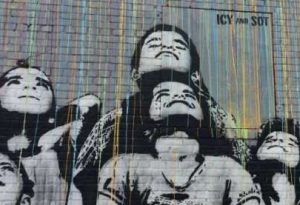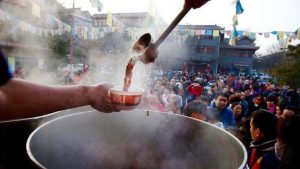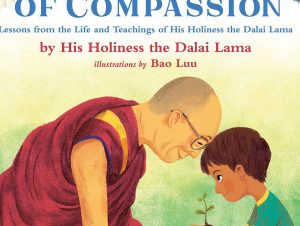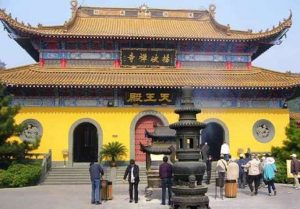This past full moon on 25 March was celebrated as the parinibbana (Pali. death of a realized one) of an ancient bhikkhuni arahant of the Buddha-era. She is none other than Venerable Bhaddakaccana Theri, better known to the English-speaking world as Yasodhara, the wife of Siddhartha Gautama.

This is extraordinary. The parinibbana dates of great arahant bhikkhus such as Sariputta and Mahamoggallana are well known and commemorated in the Theravada traditions of Sri Lanka and India. They are passed down in Pali text commentaries and remembered in yearly commemorations. Several parinibbana dates are annual state holidays in Bihar, India, the ancient heartland of Buddhism. However, until very recently, the date of Yasodhara’s parinibbana was lost to mainstream knowledge.
That is changing. Now, as the fragile palm-leaf Pali manuscripts of diverse Buddhist peoples of South and Southeast Asia begin to be scanned and made accessible online, a whole new world of Buddhist history and lived practice traditions is beginning to come to light, with the potential to greatly increase our knowledge of Buddhist history—and “herstory”—and lived Buddhist traditions.

Newly coming into awareness from the study of these manuscripts is the unexpected revelation that this past March’s full moon Uposatha, known in Pali as the Phagguna Punnami and in India as the Falgun Purnima, has been passed down in Pali and local-language manuscript and recitation traditions of mainland Southeast Asia—especially those long-preserved in southern, central, and northern Thailand—as the date of Yasodhara’s parinibbana.
Thai, Lao, Khmer, Mon, and Lanna Theravada Buddhist cultures have preserved and passed down traditions of the “Bimba Yasodhara Bhikkhuni Theri Parinibbana” (Bimba Nibbana or Yasodhara Theri Nibbana for short) in old Indic Dhamma scripts in Pali. These predate modern Southeast Asian languages and scripts by centuries, if not millennia. Among them, Khmer-Khom- and Mon-script Pali manuscript traditions of southern and central Thailand, and their related oral communal traditions, have long commemorated this date.
But of course, Yasodhara’s story, and her parinibbana, is not only known to these South and Southeast Asian manuscript traditions. Her name is celebrated throughout the annals of pre-sectarian Buddhism, the very earliest days of the Buddhist community when the Buddha walked the Earth. In the Pali-text Tipitaka, in the Sutta Pitaka’s Anguttara Nikaya “Numerical Discourses of the Buddha” collection, Yasodhara—many traditions say her monastic Dhamma name was “Bhaddakaccana,” including this tradition—was renowned as one of the Buddha’s top “etadagga” long-established and outstanding fully-awakened arahant disciples, established by the Buddha as his bhikkhuni disciple “foremost in attainment of great direct knowledge” (mahabhinnapattanam). She is, likewise, listed in one of two Ekottarika-agama parallels in Chinese translation as [Bhadda] Kaccana (迦旃) or Kaccayana Bhikkhuni (迦旃延比丘尼), while in another as Rahulamata Yasodhara Bhiksuni (羅睺羅母耶輸陀羅苾芻尼).
The early period of her life is, with some justification, more well known to the English-speaking world. Numerous books and articles, named some variation of “the wife of the Buddha,” generally focus on this early period. She was, after all, a princess, born to the local nobility, related to the Shakya clan, and married partner to Siddhartha Gautama the bodhisattva- or buddha-to-be for more than a decade, from age 16–29, or 30, depending on the counting). By all historical indications, their marriage was a self-chosen and tender one filled with marital bliss and genuine affection. Later she also came to be known as Rahulamata, or “Mother of Rahula,” the Blessed One’s son. It is by this name that she is remembered in the canonical Pali-text Vinaya Pitaka. It is generally agreed that the Great Departure of her husband genuinely caused Yasodhara emotional agony.

Few know much of the life of Yasodhara during Siddhartha Gautama’s journey before he returned to Kapilavastu for the first time, years later as a fully awakened buddha. That period of her life, along with many others, has watered the imagination of feminist writers down to the current period, for example, in Vanessa R. Sasson’s retelling of Yasodhara’s story (2018). These old Southeast Asian Pali-text manuscript traditions (likewise the Pali-text commentarial traditions), recount this intense six-year long period, as told by the Buddha’s father to the Buddha on his first return home. Ven. Tathaloka Theri gave a comprehensive overview, which is summarized here:
“When Yasodharā heard that the Blessed One (then Siddhattha, Skt. Siddhartha) had cast off his royal garb and donned kāsāya-dyed robes she too did so, when she heard he had discarded jewels and cosmetics she did as well, when she heard he no longer slept on kingly beds nor sat on regal seats and slept on the ground she too slept on the floor, and when she heard he had undertaken severe fasting she too fasted. Everything that she heard he did, she did as well. When other suitors came to request her hand in marriage (she was free to remarry as her husband had renounced), she turned them all away.”
“When he returned to Kapilavatthu (Kapilavastu) as the fully-awakened Buddha, and Yasodharā saw her husband again for the first time, these manuscripts, as well as the Pali-text commentarial traditions, recount that she held back from meeting him, even while holding Rāhula and pointing out his father among the monks. She watched from a balcony above as the Buddha’s own father Suddhodana and foster mother Mahāpajāpatī Gotamī (Skt. Mahāprajāpatī Gautamī) both became stream-enterers, while hearing the Buddha’s first teachings to them—this same full moon is also remembered as the lunar anniversary of these first teachings and their stream entry. In Yasodharā’s canonical Therī Apadāna, she again remembers and recites these same teachings four decades later just before her own Parinibbāna: the first words of Dhamma (Dharma) she heard from the lips of her beloved and now fully-awakened partner.”
(Dhammadharini)
“When the Buddha came to meet her in her royal apartments the following day, she fell to the floor, tearfully embracing his feet, which were said to be like a cooling lotus pond, quenching the burning in her heart. Then he began to recount to her one of their many partnered past lives together long ago, that he now remembered, that of the Canda Kinnara Jātaka, in which she then too was enormously faithful to him. Hearing this, she experienced a deep coming to awareness and profound reorientation; remembering, and opening the Dhamma eye—she herself then also entering the Noble Path, becoming a stream-enterer. Her tears dried and her life was transformed. What they had together strived for, for so long, began to bear the most noble of fruits in her life too.”
Directing their son Rahula to ask his father for his inheritance, Rahula followed his father to join the monastic order a week later. Yasodhara too aspired to go forth. Some texts say she was the first among women to ask to join the monastic sangha. We know from the Pali-text suttas and commentaries that Suddhodana and Mahapajapati Gotami’s only birth-son Nanda also joined the order. It is recorded in the Dakkhinavibhanga Sutta’s “The Exposition of Offerings,” that Mahapajapati Gotami, when offering robes that she had herself hand-woven to the Buddha at the Kapilavastu Nigrodharama monastery, she was strongly exhorted by the Buddha in the fundamental importance of sangha, including the dual sangha, that is “the bhikkhu–bhikkhuni sangha with the Buddha at its head,” as the supreme field of merit for offerings. As in theory, the bhikkhuni sangha did not yet exist, this was significant, and she responded.
Ven. Tathaloka Theri continues:
“When Mahāpajāpatī then asked about herself joining the monastic Order, she was advised to don robes and practice at-home asceticism, joining Yasodharā in practicing at-home with simple, basic renunciate precepts. We may note that historically, the co-contemporary Jain monastic order, developed a system of two years of precepted at-home renunciation for women preliminary to their ‘going forth’ and entering ‘left home’ monastic life. Two years later, the Buddha’s father and her husband Suddhodana, passed away. He had attained arahatship “under the white umbrella” as a layman. It was then that Mahāpajāpatī would finally set forth from the palace in robes, with bare feet and shaven head, with a large retinue of hundreds of aspiring women from among the Sakyans.”
“Translations of many of the manuscripts preserved in Thailand recount that after Mahāpajāpatī and her retinue of five hundred renounced, Yasodharā too renounced all, leaving a palace nearly emptied of her close family and kin. Some say she went forth together with Mahāpajāpatī’s birth-daughter, the extremely lovely Janapadakalyāṇī Nandā, the Buddha’s half-sister and Yasodharā’s sister-in-law, who was sometimes called Sundarī Nandā or “Nandā the Beautiful.” Her own Nandā Therī Apadāna recounts then-bhikkhunī Arahatī Mahāpajāpatī’s poignant exhortation to Nandā regarding the frailty, transience, intoxication and deceptive nature of beauty, youth, wealth, and sensual pleasures, with a clear call out to her daughter to go forth.”
(Dhammadharini)
Renouncing and disposing of all her sizable personal wealth, royal property, and royal titles, the manuscripts record that Yasodhara set forth, first going to the Buddha for his blessings, and then, blessed by him, to the Theris for bhikkhuni ordination with Mahapajapati Gotami Theri. Maha Gotami was by then a full awakened arahanti, as were several hundreds of her male and female kin—what a powerfully spiritually charged environment that must have been. They tell that not two weeks had passed when Yasodhara, intensively practicing vipassana after her ordination, likewise joined the ranks of the arahants.

All emphasize that with her full awakening, she gained not only a normal arahant’s level of supernormal powers and higher knowledge, but an extraordinary level—with her ability to remember far, far back in time, through long, practically innumerable eons, a level of knowledge attained by only the Buddha himself, his two chief bhikkhu disciples, Sariputta and Mahamoggallana, and the arahant Bakkula Thera.
In some ways, her psychic powers were said to be second only to those of the Buddha himself. Due to her unparalleled parami, Yasodhara, as a gifted bhikkhuni arahant, became the leader of a very large following of bhikkhuni arahatis with noble attainments. The numbers vary from more than a thousand to 196,000. She was sought by people desiring merit through making offerings, due to the level of perfection of her dana parami. Her knowledge and her conduct were spoken of by the Buddha himself as a female “lion’s roar.”
According to Ven. Tathaloka Theri:
“These extraordinary virtues and abilities of the awakened arahant bhikkhunī Yasodharā, or Bhaddā Kaccānā Therī, are highlighted not only in the canonical Pali texts and mainstream Pali-text commentaries, but also in parallel Indic traditions in the Chinese Tripitaka transmitted in the fourth and fifth centuries by monks from the regions to the northwest of India, Kashmir, Khotan and Gāndhāra.”
(Dhammadharini)

In the Ekottaragama, her exceptional faith is highlighted in the “[Outstanding] Bhikkhunis” chapter 《增壹阿含經比丘尼品》in EA 5.1–5. Her supreme merits are remembered in “The Buddha Speaks of the Virtues of the Arhats”《佛說阿羅漢具德經》in T126. Finally, she is lauded for her great spiritual powers in the Chinese translation of the Southern Tipitaka in the teachings on the foundational karma and merits of the “500” great bhikkhu and bhikkhuni arahants whose past lives are told in the Apadanas《譬喻經》.
The Pali-text Tipitaka’s Yasodhara Theri Apadana, as well as these manuscript traditions, all directly point to such supernormal power with regards to memories, the Lanna manuscripts including as many as 30 or even more than 50 Jataka past life stories together. These highlight the Buddha and Yasodhara’s eons of spiritual partnership, most all recording a crucial juncture with the famous fateful encounter when he was the rishi Sumedha and she the brahmin maiden Sumitta.
Sumitta shares five of her eight lotus flower offerings with rishi Sumedha. In great devotion, Sumedha lays his body across a muddy ditch in the road, inviting the Buddha to cross over, Sumitta’s heart being enormously moved by this. They both receive predictions from the ancient Buddha Dipankara: he to Samma Sambuddhahood, and she as “like minded” partner on the bodhisatta path, to savaka buddhahood—the full awakening and arahantship of disciples of a Samma Sambuddha.
The canonical Pali text Theri Apadana, which records past-life and parinibbana stories of more than 500 Buddha savakas and savikas, including both Mahapajapati Gotami and Yasodhara Theri, has been made freely available in English translation by Jonathan Walters, on the SuttaCentral website and on the Legends of the Buddhist Saints website at Apadana Translation since 2018. However, it was in the Chinese and Tibetan canons’ parallels of these same theris’ parinibbana stories—thanks to the scholarship of Ven. Bhikkhu Sujato, and of Ven. Bhikkhu Analayo and Ven. Bhikkhuni Dhammadinna—that the date of Mahapajapati Gotami’s Parinibbana date was rediscovered, and commemorations begun again for the past 10 years. Commemorations began in their Indian homeland again in Vaishali in 2020.
For Yasodhara Theri, parallel apadana manuscripts from Sri Lanka, recording her Parinibbana stupa and relics—which the Yasodhara Therī Apadana implies but does not mention—were published by Ranjani Obeysekere in 2009 in the book Yasodharā, the Wife of the Bōdhisattva: The Sinhala Yasodharāvata (The Story of Yasodharā) and the Sinhala Yasodharāpadānaya (The Sacred Biography of Yasodharā). The book does not have Yasodhara Theri’s parinibbana date.
Ven. Tathaloka Theri learned of the long-standing mainland Southeast Asian Pali-text manuscript traditions introduced above—and recorded within them this very special commemorative date—just on the eve of the beginning of the Dhammadharini annual winter retreat in January this year. The Yasodhara (Bhaddakaccana) Parinibbana date recorded within, on the full moon of March this year, fell coincidentally on the very day of the final Uposatha program of the Dhammadharini winter retreat, three months later.
This year’s final retreat full moon Uposatha program, originally on the topic “The Character of the Stream Enterer,” therefore became a launching of awareness and remembrance. In past years this would entail a remembrance of the stream entry of the Buddha’s father and guardian mother. This year went further. As retreat lead teacher Ven. Sobhana Theri said, it was “an enormously powerful time for reflecting on Nibbana.” It was a happy conclusion to Women’s History Month, and to the 2024 winter retreat’s focus on stream entry, with its natural culmination in the ultimate, parinibbana.
In these manuscripts, not only is the date of Yasodhara’s Parinibbana found, but also her chosen location: the not-yet-rediscovered bhikkhuni arama to the northwest of Savatthi near the Aciravati River (now a dried branch of the River Rapti), together with further information about her cremation, relics, and stupa. This information, published in Romanized Pali, was pointed out by a scholar of mainland Southeast Asian Buddhism, the author of Until Nirvāna’s Time, Trent Walker, as published in the critical edition of a collection of the central and southern Thai Pali-text manuscripts preserved in Khmer-Khom and Mon scripts.
This critical edition was published in 2003 by researchers Siam Phattharanuprawat and Rungroj Phiromanukul in Roman-Pali with Thai translation in the volume, Examination and Analytical Study of the Pali Language Edition of the “Bimba Bhikkhuni Nibbana” Scripture (Thai:การตรวจชำระและการศึกษาเชิงวิเคราะห์คัมภีร์พิมพาภิกขุนีนิพพานฉบับภาษาบาลี).

To be sure, we cannot prove that the Buddha’s own date of his Mahaparinibbana is historically accurate—the Southern Theravada Buddhist traditions commemorate it annually on a different month than the Northern Buddhist traditions of East Asia. Nevertheless, one can see how such a date, whether that of the Buddha, or of his arahant disciples, as handed down by the traditions, can be informed and confirmed by such old manuscripts. As well as affirmed through the living traditions of Buddhist peoples, both locally and internationally.
In regard to the latter, Thai Buddhists have been commemorating and observing this date annually for some time, as seen in the past 15 years of social media posts. What is the Phagguna Punnami recorded in the Pali manuscripts, has been translated as the corresponding 15th day of the waxing moon of the fourth lunar month on the Thai calendar, this year the March full moon.
When this day is remembered and commemorated by Thai Buddhists as the day of the Bimba Yasodhara Bhikkhuni or Bhaddakaccana Theri Parinibbana, it is as part of the traditional practice of Sanghanusati, “Recollection of the Noble Sangha.” For those with Thai Buddhist friends on social media, year after year we might see posts like this made by a faithful Thai Buddhist on this just past full moon day, in commemoration and Sanghanusati remembrance:
วันนี้เป็นวันพระขึ้น ๑๕ ค่ำ เดือน ๔ เป็นวันคล้ายวันนิพพานของพระนางพิมพาภิกษุณีเถรี หรือ อีกพระนามนึงคือ พระภัททากัจจานาเถรี พระเอตทัคคะผู้เป็นเลิศในอภิญญาใหญ่กว่าภิกษุณีทั้งปวง พระนางพิมพาเถรี เข้าสู่อนุปาทิเสสนิพพาน ณ พระอารามภิกษุณี กรุงสาวัตถี ในพรรษาที่ ๔๓ แห่งพระสมเด็จผู้มีพระภาค วันนี้จึงเป็นวันสำคัญทางพระพุทธศาสนาที่ให้ระลึกถึงคุณงามความดีเป็นสังฆานุสติอีกวันหนึ่ง
Today [March 24th-25th 2024] is the 15th day of the waxing moon of the 4th lunar month [on the Thai calendar]. It is the anniversary of the Nirvāna of Venerable Lady Bimbā Bhikkhunī Therī also known as Phra Bhaddākaccānā Therī, the Venerable Etadagga [Sāvikā], who is foremost in [the Higher Knowledges] Abhiññā of all the Bhikkhunīs. Venerable Lady Bimbā Therī entered Anupādisesa-nibbāna at the Bhikkhunī Upassaya Ārāma in Sāvatthi in the 43rd year of the Blessed One’s Vassas. Today is therefore an important day in the Buddha Sāsana to remember the good deeds [of noble Arahantas] as Sanghānusati.
(Facebook)
The Dhammadharini community celebrated this important anniversary of a great awakened arahati disciple of the Buddha with a Zoom full moon Uposatha program this past 25 March Phagguna full moon, Yasodhara parinibbana anniversary day, live-streamed on YouTube and Facebook Live. As this was Dhammadharini’s first year doing so, and this tradition was not yet known to the English-speaking world, part of the mission was a “launching of awareness,” falling propitiously within the final week of Women’s History Month. The hope is to share the “HerStory” of the ancient, great and fully-awakened female disciples of the Buddha. Such recollection and commemoration is also an essential part of the canonical practice of Recollection of the Virtues of the Arahants, as well as a part of widespread traditional Buddhist practice of Sanghanusati, or “Recollection of the Noble Sangha.”

There will always be complexities around studying a truly pre-historic era like the Buddha-era: a period of history of which we have no contemporaneous records and can only rely on epigraphy, archeology, and ancient manuscripts from mostly Central Asia to reconstruct Buddhism’s first two millennia. But we can, in the spirit of religious humility, trust the transmitted traditions to say something meaningful about what they have learned and remember of the figures of that era, and the values that they represent.
So we might ask about Yasodhara’s humanity, and what she taught her contemporaries and continues to reveal to us. She embodied a spirit of forgiveness that poignantly speaks to our troubled hearts and relationships. She embodies an ideal of perseverance that seems almost superhuman. Yet her success in leaving behind her old life and taking up a meaningful cause that filled the void in her heart strikes one as almost modern. Her voice continues to echo, from the Buddha-age to our age. All one needs to do is listen.
See more
“Launching of Awareness” Honoring the Parinibbāna Day of Bimbā Yasodharā (Bhaddā Kaccānā) Therī” (full moon 25 Mar 2024, English, audio-visual) (Dhammadharini Monastery) (YouTube)
Yasodhara and the Buddha (Barnes and Noble)
The Legends of the Therīs / 28. Yasodharā (English translation of the canonical Pāli-text Yasodharā Therī Apadāna) (Jonathan Walters)
Yasodharā Therī Apadāna (Romanized Pāli) (Mahāsaṅgīti Tipiṭaka Buddhavasse 2500)
Yasodharā, the Wife of the Bōdhisattva: The Sinhala Yasodharāvata (The Story of Yasodharā) and the Sinhala Yasodharāpadānaya (The Sacred Biography of Yasodharā) (English translation from the Sri Lanka Pāli-text and Sinhala manuscript traditions) (Ranjani Obeyesekere)
Lasting Inspiration “Mahāpajāpatī’s Exhortation” (English translation from the Pāli) (Tathālokā Therī)
“Bimbā Yasodharā Therī Parinibbāna” Diary of Discovery (English) (Facebook)
การตรวจชำระและการศึกษาเชิงวิเคราะห์คัมภีร์พิมพาภิกขุนีนิพพานฉบับภาษาบาลี | นักวิจัย : สยาม ภัทรานุประวัติ, รุ่งโรจน์ ภิรมย์อนุกูล, ปี : 2546 BE (“Examination and analytical study of the Pali language edition of the ‘Bimbā Bhikkhunī Nibbāna’ scripture” 2003 CE) (Thai, Ch. 3 with Romanized Pāli critical edition) (Siam Phattharanuprawat and Rungroj Phiromanukul)
Further resources
(e-publication, book chapters) “สมเด็จพระนางพิมพาภิกษุณี, จาก หนังสือ วิมุตติรัตนมาลี, รจนาโดย พระพรหมโมลี” | “Her Holiness Venerable Lady Bimbā Bhikkhunī” from Vimuttiratanamālī, final chapter “สมเด็จพระพิมพาดับขันธนิพพาน” | “Her Holiness Venerable Bimbā Passes Away to Nibbāna” (Thai, a traditional Thai summary of her life story including her Pārinibbāna, cremation, relics, and Parinibbāna relic stupa) edited by Phra Brahmamolī
(e-publication, article) “Arahant Bhaddakaccānā (Yasodharā): Foremost Nun in Deep Knowledge (Mahābiññā)” (English, a good overview, based on canonical and commentarial Pāli-text sources popularly known in Sri Lanka) by Dr. Ari Ubeysekara
(e-publication, book chapter) “第一冊•第十一章 大神通第一比丘尼──耶輸陀羅(Yasodharā)” | “Volume 1 • Chapter 11 The First Bhikshuni with Great Supernatural Powers—Yasodharā” (Chinese, a good overview based on canonical and commentarial Pāli-text and Southern China canonical sources) by Shì Le Jué and Shì Le Chén
Apadana Transation
Related features from BDG
Gender Equity: Time to Wake Up!














I appreciate your great Dhamma services. Please keep posting.
Thank you, Prof. Rao!
I would like to acknowledge that, while this much appreciated article speaks to what are often “The Missing Years” of this great arahant Therī’s monastic life, and this is much needed in English, it does not actually tell the story of her Parinibbāna as it is told in the old mainland Southeast Asian Pāli-text manuscript traditions. Not yet.
That part is yet to come!
It also does not share with the reader the ancient and contemporary stupa and relic locations in India, Sri Lanka and Thailand — which have been researched and are being researched now, and are significant.
That part is also yet to come.
Last, but not at all least,
During the preparation of our Dhammadharini commemorative program this past March full moon, during the program, and in the days following, we learned (i learned) a lot about how and why this great Arahant Therī is meaningful–in diverse and multifaceted ways–to diverse people.
There is much to unpack here, for honest discussion, for contemplation, for writing, voicing, painting… Thank you Venerables and Dhamma friends, who have shared your heartfelt thoughts and feelings with us.
Our lives are enriched through this sharing.
And thanks very much with “anumodana!” to the Buddhistdoor Global team. Much, much appreciation for this, and for all your Dharmic work.
There is much material here of value and worth for further unpacking in years to come as we and others around the world, reawakening awareness, now begin–once again–to annually commemorate the Parinibbāna Day of this great arahant Therī.
Thanks for this article, Raymond, it’s great to see stories of the ancient bhikkhunis and to make them more alive and sources of inspiration for us now!
Interesting and educating content about Mahateri Yasodhara. Thanks for such a wonderful article. Can we translate and publish in a local magazine, with due credits?